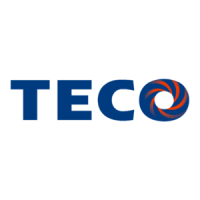4-143
10- 02
PID target value
Range
【
0.0~100.0】%
10- 03
PID control mode
Range
【xxx0b】:
PID invalid
【xxx1b】: PID valid
【xx0xb】:
PID positive characteristic
【xx1xb】: PID negative characteristic
【x0xxb】: PID
error value of D control
【x1xxb】: PID feedback value of D control
【0xxxb】:
PID output
【1xxxb】: PID output +target value
10- 04
Feedback gain
Range
【
0.01~10.00】
10- 05
Proportional gain (P)
Range
【
0.00~10.00】
10- 06
Integral time (I)
Range
【
0.0~100.0】Sec
10- 07
Differential time (D)
Range
【
0.00~10.00】Sec
10- 09
PID bias voltage
Range
【
-100~100】%
10- 10
PID Primary delay time
Range
【
0.00~10.00】%
10-14
PID integral limit
Range
【
0.0~100.0】%
10-23
PID limit
Range
【
0.00~100.0】%
10-24
PID output gain
Range
【
0.0~25.0】
10-25
PID reversal output selection
Range
【0】:
Do not allow the reversal output
【1】: Allow the reversal output
10-26
PID target acceleration / deceleration time
Range
【
0.0~25.5】Sec
Use PID control
PID control function, (P) proportional, (I) integral, and (D) differential, play the roles to
reduce the deviation between the target command and the actual control value.
PID Control operation
Characteristics outline of the PID control is as following:
. P control : A difference (deviation) between the input command (set value) and the
actual control value (feedback). This difference or deviation will be
amplified by a set gain (P), control and reduce the system deviation.
Although the gain is increased, system might still be unstable.
. I control : This control allows that the relative gain (P) is integrated in time. Therefore,
a high gain may be used in results with small deviation. When the integral
time (I) is increased, the system response will be reduced.

